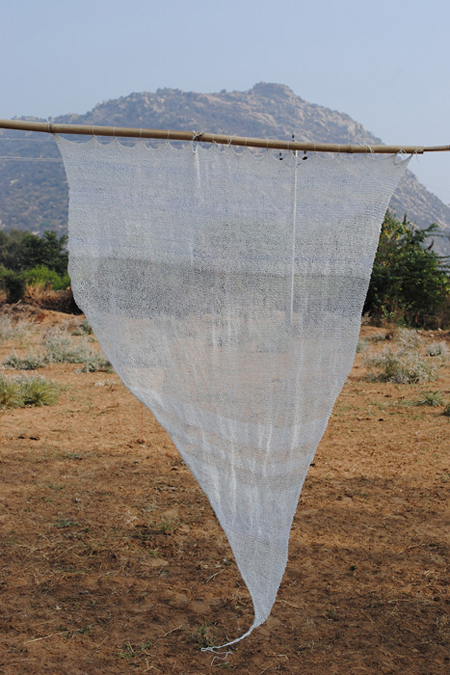Unartisanal ||
Back to exhibition
Marcy Chevali
What draws you to the materials you work with?
In "Thin" I used a simple cotton thread that was easy to find and readily available. I wanted it to be accessible and quick, not something that would get in the way of what I wanted to say or need interpretation. In India, where I made this piece, cotton became one of the first cottage industries and a symbol of the nation's fight for independence.
Why "craft" and not "art"?
Art is precious and is made by someone with special skills and special access. Craft is for everyone. It can be done as part of a community, either everyone working together on one project or people working on individual projects. It is something that can easily be pulled out to be worked on and just as quickly put away, easy to squeeze in around other daily activities.
In what ways are you expanding upon the realm of craft?
I think craft usually has a function. Sometimes that function is not important but it's still there. Bringing craft into the realm of art can sometimes give it the label "functionless". Though in reality it does have function, it's a symbolic or cerebral function, rather than practical. This is a nice combination as craft is so humble and utilitarian.
Is your work rooted in any specific traditions or techniques?
I often knit. I've used a fisherman's net knot technique that I learned from a book though I'm not entirely sure that I'm doing it right. I often teach myself so my technique can be far from perfect or traditional.
How do you navigate "craft" while avoiding popular trends?
I've never been one to follow popular trends, at least not successfully. My work is often very personal and deals with my particular set of circumstances. I strive to touch on the universality and the emotion of the experience. Even though a viewer has not had my specific experience, I hope that they can relate to the piece with whatever their own emotional connection is, or even a political or community situation.
Do you consider craft utilitarian, or decorative, or both/neither? Why?
I think both, or whatever it needs to be at the time. Sometimes the object is important, sometimes the process of making it is important.
Why do you think so many people are returning to fiber arts these days?
Why did they ever leave? I think that in an increasingly digital world we have an unfulfilled sense of touch. Also a need to slow down in an ever increasingly speedy world.
How has the pandemic affected your practice?
Prior to the pandemic I was working primarily with glass. Without access to glass working facilities, I brought my work into materials that I could easily work with at home. I think it was helpful to have that break in my work, to have the chance to re-examine what was essential to my work and build out from there.
Marcy Chevali is a visual artist with an MFA from the Maine College of Art. She has shown work in galleries and artists' spaces including Villa Terrace Decorative Arts Museum, Queens Museum of Art, AIR Gallery, Gallery Aferro, and Jamaica Center for Arts and Learning, and with organizations such as South Asian Women's Creative Collective, Hudson Valley Center for Contemporary Art, ABC No Rio, Project for an Empty Space, 4heads and Peculiar Works Projects. She was awarded an artist grant from the Queens Art Fund in 2015. In 2016, she attended Playa Artists Residency and in 2017, she was a fellow at the Edward Albee Foundation. In 2019, she was an artist in Baie Set Marie, Nova Scotia and at Farm Studios in Rajasthan, India. She had a solo presentation of her work at Aicon Gallery in 2021.
Marcy has always had an affinity for strings and their way of connecting things both literally and symbolically. Themes of absence, fragility and stillness recur in her work.
Unartisanal is funded in part by the New York State Council on the Arts and the
New York City Department of Cultural Affairs
Unartisanal ||
Back to exhibition

